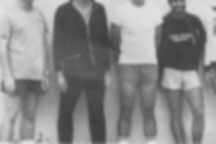
Contributor's Note

Michael Martone was born in Fort Wayne, Indiana, and grew up there. When Martone was in high school, it was often commented upon by family, friends, acquaintances, and even total strangers that he looked like Paul McCartney, one of The Beatles, a British rock and roll band that had recently visited America for the first time selling records, playing concerts, and appearing on television programs such as The Ed Sullivan Show. Soon after that, The Beatles first movie, Hard Day's Night was released. By that time Martone had let his dark brown hair grow longer like most of the other boys in his school, and the longer hair increased the occasions when he received comments about his uncanny resemblance to the singer/songwriter. He imagined that he could see something around his eyes, the drape of his lids, he supposed, or there was an echo of the angle of McCartney's chin in Martone's own. But it was mostly the hair, he supposed, falling straight down his broad forehead to his overly bushy brow that he had only recently begun shaving on the bridge of his nose. Coincidentally, Martone was involved with a short-lived cover band inspired by the success of The Beatles performance in the movie. The new band would lip synch the songs and imitate The Beatles goofy antics, being pursued through the neighborhood by their screaming younger sisters. His bandmates, excited by Martone's evolving mimicry of one of their role models, urged Martone to take up the electric bass and begin memorizing the lyrics from Meet the Beatles. Oddly, and for reasons too complicated to explain here, Martone preferred to play the part of the band's manager, Brian Epstein, whose looks nobody then had any idea of, and stay backstage safely out of sight. Over time, Martone's and McCartney's shared facial characteristics began to diverge. For one thing Martone gained weight, his cheeks becoming even fuller and rounder than they had been, his neck merging with his chin and jaw line. McCartney's face, on the other hand, began to sag and the folds under his eyes grew deeper in shadow, the lids more hooded, setting the eyes themselves deeper in their sockets. There came a point when the casual mentions concerning the similarity of their shared appearance ceased all together. People would stare in startled confusion into Martone's face when he mentioned that once other people thought he looked like Paul McCartney. "I don't see it," they would say. There was a time, then, as he approached adulthood when Martone, as far as he could ascertain, looked like no one but his parents. His mother always said that if you broke Martone's face in two, the top half favored his father especially the nose and eyes but that the lips and chin were undoubtedly her contribution. Soon, Martone began to receive more and more comments that would draw a comparison between his appearance and that of an emerging character actor from Chicago named Joe Mantegna whose face, of course, was memorable but whose name unfortunately was not. Mr. Mantegna was, often for Martone's informants, the guy, you know, the actor in Things Change or House of Games or later the last Godfather. "Joe Mantegna?" Martone would answer once the pattern had become clear. And the resemblance was and is remarkable. Once, Martone, himself, had to look twice at a film still printed in his local newspaper. What, he thought at the time, am I doing in the newspaper? The similarity is most striking from a certain angle and stronger in profile. For some roles Mr. Mantegna will grow a beard, and Martone, whose hair now is best described as salt and pepper, believes that the actor probably colors his. Recently, another name, an actor again, is mentioned when people are moved to compare Martone's looks to others. Adam Arkin, the son of the actor Alan Arkin who he, Adam, resembles, comes up almost as frequently as Joe Mantegna as someone Martone looks like. Or when someone is searching for Joe Mantegna's name to tell Martone that he looks like him, he or she will say, you know, it is the actor that looks like the actor who is Alan Arkin's son. Martone suspects it is the eyes, the shape of the head, the hair where his face and the faces of these actors intersect. At a wedding reception recently, the mother of the bride commented in the receiving line that Martone had George Clooney's eyes, and, later that night, Martone pondered this new information. It just so happened that One Fine Day starring George Clooney was being shown on television. Martone stared at George Clooney's eyes as they appeared on the television screen before him, attempting to see the likeness but found, perhaps because he was a bit drunk from the wedding reception, that it was very difficult to look at someone's eyes or a picture of someone else's eyes then look at your own eyes in a mirror in order to determine if the two sets of eyes look in any way the same. The eyes on the screen and in the mirror kept moving. Secretly, Martone believes that he looks most like a cartoon character named Fred Flintstone. The particulars all seem to be a match. The thick neck, the shadow of the beard, the dark eyes and hair. Martone realizes that his self-image is probably a distortion, a projection of his own insecurities about his real appearance, but he can't help himself. And he isn't too surprised that when, in an unguarded moment, he asks someone he has just met if doesn't think that he, Martone, isn't the spitting image of Fred Flintstone, and the acquaintance squints and says, "Yes, I can see that."

About the author:
Michael Martone was born in Fort Wayne, Indiana. He is currently completing a book entitled Contributor's Notes, a memoir, made up of contributor's note published in the contributors' notes section of magazines.
